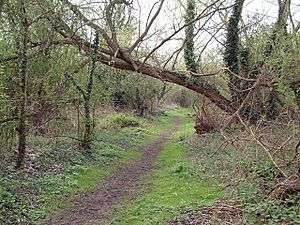Wraysbury and Hythe End Gravel Pits facts for kids
| Site of Special Scientific Interest | |
 |
|
| Area of Search | Berkshire |
|---|---|
| Interest | Biological |
| Area | 117.2 hectares (290 acres) |
| Notification | 1992 |
| Location map | Magic Map |
Wraysbury and Hythe End Gravel Pits is a very important natural area in Wraysbury, Berkshire. It is a Site of Special Scientific Interest (SSSI). This means the area is protected because it has rare plants, animals, or geological features.
The site covers about 117 hectares, which is like 290 football fields. It is also part of a larger protected area. This larger area is called a Ramsar site and a Special Protection Area. These names mean it's super important for birds and wetlands around the world.
This special place has four old gravel pits. These pits are now filled with water. The area is also near the River Thames and the Colne Brook. This means it's often in their floodplains. The site is especially important because many different kinds of birds live there.
Contents
Amazing Animals at the Pits
This natural area is home to many different animals. It is a great place for wildlife watchers.
Birds You Might See
Many types of birds visit or live at Wraysbury and Hythe End Gravel Pits. Some birds stay all year, while others visit during migration.
- Tufted duck
- Gadwall
- Common merganser
- Diving duck
- Common goldeneye
- Smew
- Common pochard
- Wigeon
- Mandarin duck
- Shelduck
- Common kingfisher
- Grass warbler
- reed warbler
- Common redshank
- coot
- Heron
- Little egret
- Common buzzard
- Water Rail
- Ring-necked Parakeet
- Grey Wagtail
- Reed Bunting
- Swift
- Common chiffchaff
- Garganey
- Hobby
- Streptopelia
- Common nightingale
- Wheatear
- Whinchat
- Horned grebe
- Red-necked grebe
- Black-necked grebe
- Long-tailed duck
- Red-breasted merganser
- Common sandpiper
- Green sandpiper
- Little ringed plover
- Common ringed plover
- Snipe
- Jack snipe
- Lesser redpoll
- Lesser scaup
- Ortolan bunting
Tiny Invertebrates
Even small creatures like invertebrates live here. These are animals without backbones. They are important for the ecosystem.
- Platycnemis pennipes (a type of damselfly)
- Oulimnius major (a type of beetle)
- Leptocerus lusitanius (a type of caddisfly)
Wonderful Plants at the Pits
The site also has many different types of plants. These plants provide food and shelter for the animals.
Trees You Can Find
Some trees grow well in this wetland environment.
- Rhamnus catharticus
- Salix fragilis (Crack Willow)
Other Plants
Many other plants thrive in the wet conditions of the gravel pits.
- Phragmites australis (Common Reed)
- Carex acutiformis (Lesser Pond-sedge)
- Carex riparia (Greater Pond-sedge)
- Potamogeton pusillus (Small Pondweed)
- Typha latifolia (Bulrush)
- Bidens tripartita (Three-lobed Beggarticks)
- Zannichellia palustris (Horned Pondweed)
- Lathyrus nissolia (Grass Vetchling)
- Carex spicata (Spiked Sedge)

